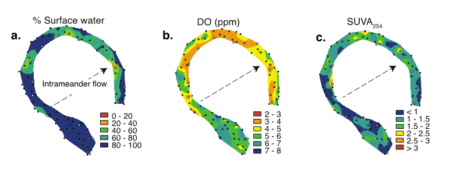
Intrameander flow paths result in lateral heterogeneity in streambed surface water-influence (a), dissolved oxygen (b), and specific UV absorbance at 254 nm (SUVA254, c, indicator of organic compound aromaticity). Water flow in channel is clockwise.
During baseflow within an alpine river, meander morphology was found to cause lateral spatial variability in channel hyporheic flow and drive streambed biogeochemical conditions. Sinuosity-induced intrameander flow paths affect the source and lability of dissolved organic matter, and streambed microbial community composition shifts with chemistry conditions, although communities are all similarly diverse.
The progression of climate change is resulting in earlier snowmelt onset and reduced snowpack in alpine regions, causing a longer baseflow period for alpine streams and subsequently impacting streambed flow and biogeochemical processes. This study characterized streambed biogeochemistry at high-resolution during baseflow to constrain how nutrient cycling in alpine watersheds may shift with climate change.
Summary
The authors conducted a high-resolution characterization of streambed hydrology and biogeochemistry around a prominent meander bend within the East River (Crested Butte, CO) and found sinuosity-induced heterogeneity in hyporheic flow, pore water chemistry, and microbial community composition. The presence of intrameander flow paths result in spatial heterogeneity in the upwelling and downwelling of water, and subsequent surface water influence in the streambed. Surface water downwells in a large recharge zone on the up-valley side of the meander, and discharges on the down-valley side of the meander. Variability in hyporheic flow resulted in similar patterns in pore water chemistry and concentrations of substrate for microbial metabolism. Regions of the streambed with large surface water influence have higher dissolved oxygen concentrations, relatively low metal concentrations, and more labile, fresh dissolved organic matter. Contrastingly, groundwater-dominated regions have low dissolved oxygen and high metal concentrations, and more recalcitrant dissolved organic matter. Lateral heterogeneity in pore water chemistry drives microbial community composition, although streambed microbial communities are similarly diverse. The authors’ findings enhance understanding of hyporheic biogeochemical conditions during baseflow, which is expected to lengthen with climate change.
Citation
A. R. Nelson, A. H. Sawyer, R. S. Gabor, C. M. Saup, S. R. Bryant, K. D. Harris, M. A. Briggs, K. H. Williams, M. J. Wilkins (2019), “Heterogeneity in hyporheic flow, pore water chemistry, and microbial community composition in an alpine streambed.” Journal of Geophysical Research: Biogeosciences, DOI: 10.1029/2019JG005226
